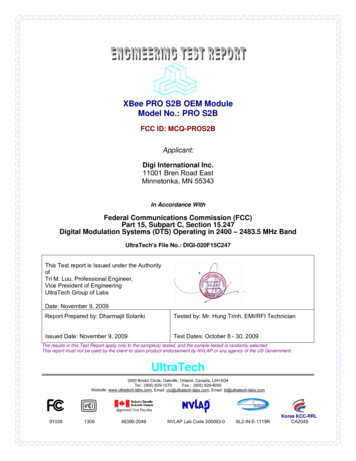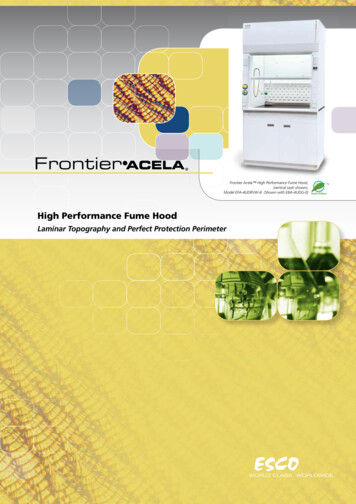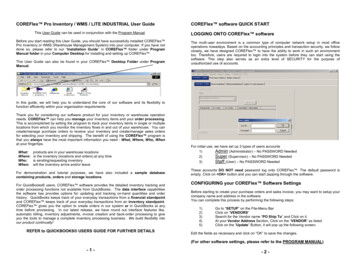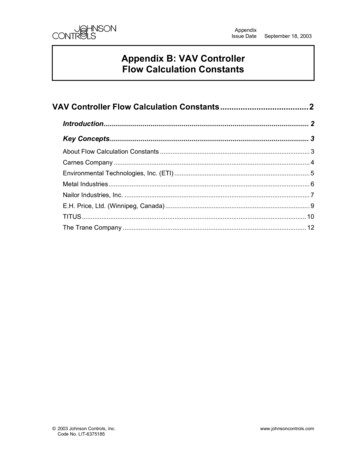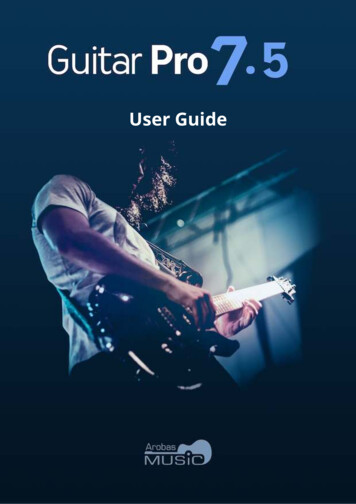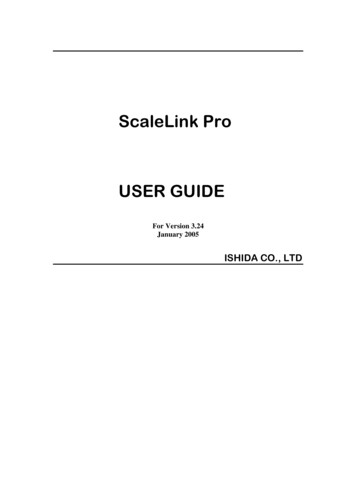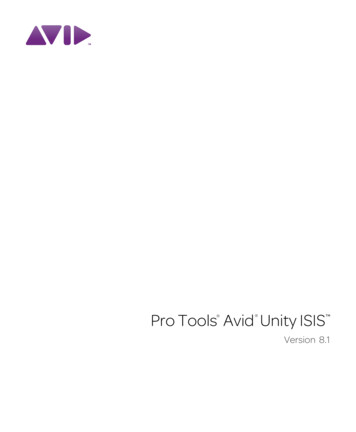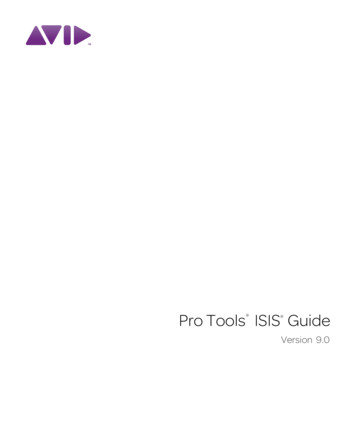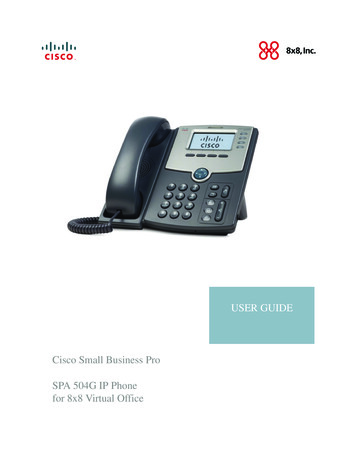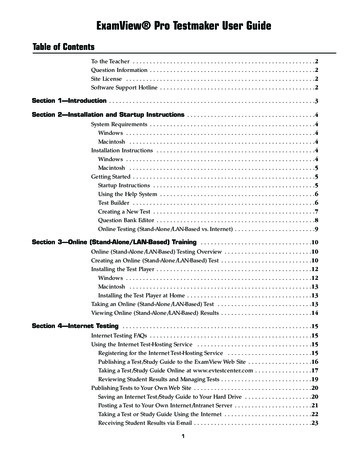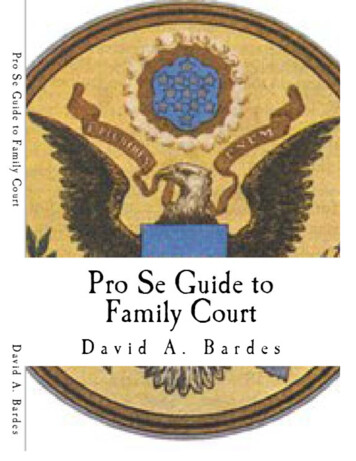
Transcription
Pro Se GuideToFamily CourtBy David A. Bardes, Sui Juris"All tyranny needs to gain a foothold is for peopleof good conscience to remain silent."Thomas Jefferson
David A. Bardeswww.proseguidetofamilycourt.comCopyright 2011 David A. BardesAll rights reserved.ISBN-13: 978-1461123910ISBN-10: 1461123917ii
DEDICATIONTo my beloved mother, Eunice Hood Bardes, whom at my age of twelvewhen I was dragged in front of a family court judge who asked me whichof my two parents I no longer needed, I turned my mother into a visitorand started the greatest regret of my life. Mom, I am sorry that I did nottell the judge that I needed both parents. I had unknowingly joined thefirst generation of family courts victims in the United States.To my beloved children, DAB and APB, to whom by no fault of their ownjoined the second generation of family court victims in the UnitedStates. I am doing everything I can to prevent your children frombecoming a third generation of family court victims.
CONTENTSChapter 1: Introduction, Page 81.1 Why Did I Publish This Book?1.2 What I Need You to Do With This Book?1.3 What is “Constant Litigation?”1.4 What does “Pro Se” mean?1.5 Assumptions Supporting This Book1.6 Who is the Target Audience of this Book?1.7 Distribution of this Book1.8 Do Pro Se Litigants Have Any Power in Family Court?1.9 Why Did I Write this Book?1.10 The Unauthorized Practice of Law1.11 Why a Lawyer Could Not Write this Book1.12 My Legal Experience1.13 A Note On My Ex-Wife1.14 Increasing Numbers of Pro Se Litigants1.15 Use of Legal Terminology1.16 Litigation Defined1.17 Pleadings Defined1.18 Adjudication Defined1.19 Burden of Proof Defined1.20 Criminal Court vs. Civil Court1.21 State Courts vs. Federal Courts1.22 Jurisdiction Defined1.23 The "Court" Defined1.24 Clean Hands, Unclean Hands, Good Faith, Bad Faith1.25 Victim Defined, Victim Class Defined1.26 Injury Defined, A legal Injury Defined1.27 Redress and Remedy Defined1.28 Generalizations1.29 The 80/20 Rule1.30 Gender Issues1.31 Footnoted Statistics in this Book1.32 State by State Family Court Laws1.33 The Family Rights Movement1.34 Lawyer Magic1.35 Indigent, Indigence, Indigency Defined1.36 The Power of the Written Letter1.37 Your Character1.38 Politics/Religion/Racial Issues1.39 Jails v. Prisons vs. Federal Prison1.40 The Anger Issue1.41 Suicide, Suicidal Thoughts
Pro Se Guide to Family CourtChapter 2: Your Legal Training, Page 552.1 What is The Public Trust?2.2 Equality Feminism vs. Hard Core Man Hatters2.3 Tender Years Doctrine Movement2.4 No Fault Divorce Movement2.5 The Deadbeat Dad/Mom Movement2.6 History of the Family Court in the United States2.7 The Replacement of Marriage2.8 Three Alternatives to Family Court2.9 The 50/50 Split Custody Alternative2.10 The Shared Parenting Alternative2.11 The Divorce Guru Alterative2.12 Statistical Advantages and Disadvantages That You Will Face In Family Court2.13 Introducing The Concept of Rights2.14 The United States Constitution2.15 Basic Constitutional Law2.16 Basic Contract Law2.17 Written Law, Case Law, and the Judges Law2.18 Law Enforcement2.19 Live in Boyfriends, Girlfriends, and Step Parents2.20 The Guardian Ad Litem2.21 Parental Alienation Syndrome - PAS2.22 Affidavit of Perjury2.23 The Domestic Violence Industry2.24 The Social Services Departments2.25 Warning Against Doing your Own InvestigationsChapter 3: Courtroom Preparation, Page 933.1 The Basic Set Up of a family Court Courtroom3.2 Jurisdiction3.3 Know Your Rights Before You go to Family Court3.4 The Family Court Judge3.5 The Family Court Lawyers3.6 Speak For Your Children3.7 Your Rights to a Continuance3.8 Anger and Emotions3.9 Why Pro Se?3.10 Outstanding Warrants for Arrests3.11 Support Modifications (Definition: Substantial Change of Circumstances)3.12 The Transcript3.13 Weasel Words3.14 Torts3.15 Criminal Allegations, Admissions of Crime3.16 Existing Criminal Records3.17 Charges for Domestic Violence3.18 Claiming, Defending Religion3.19 Claiming, Defending Politicsv
David A. Bardes3.203.213.223.233.243.25Discovery DefinedHow Civil Contempt WorksCourt RulesLawyers Have to Follow all the Rules, You Don’tDetailed Financial StatementsGoing for 100% CustodyChapter 4: Active Litigation, Page 1254.1 Introduction4.2 Initial Power Phrases4.3 When You Can Speak and to Whom4.4 You Have to be Believable and Sincere4.5 What is Litigation?4.6 How to Attack Legally4.7 Some Further Miscellaneous Attacks on the Lawyer4.8 Deny, Deny, Deny, Refute, Refute, Refute, Demand Proof, Proof, Proof4.9 How to Deny Depression and Loaded Guns4.10 Overcoming General Mental Illnesses4.11 Retract and stricken from the record4.12 Drugs and Alcohol Abuse are the Most Common Attacks Used, So Expect Them4.13 Acting in the Best Interest of your Children4.14 When the Judge Interrupts You4.15 How to Handle Witnesses4.16 Affidavits4.17 Objections, Overruled, Sustained4.18 Prejudice and Bias4.19 Ask and Answered4.20 If You Can Get Your Ex-Spouse on the Witness Stand under Oath4.21 Sanctions4.22 The Guardian Ad Litem4.23 Putting the Close on the Judge4.24 If You are Going Down in FlamesChapter 5: Pleadings, Page 1495.15.25.35.45.55.65.75.85.9Basic Pleading Advice for Pro Se LitigantsPetitions vs. ComplaintsMotionsCounter MotionsObjectionsAffidavitsAffidavit of PerjuryFactsPrepared Ordersvi
Pro Se Guide to Family CourtChapter 6: Post Adjudication Advice, Page 1586.1 Conclusion6.2 The Ultimate Power of the Pro Se LitigantSupplemental Chapter:How to Get a Family Court Judge Fired, Page 164Supplemental Chapter:Preparing For and Surviving Jail, Page 168Supplemental Chapter:Radical Shared Parenting, Page 179vii
Chapter 1Introduction“The whole concept of putting families on trialsends out all kinds of alarms.”8
Pro Se Guide to Family Court1.1 Why Did I Publish This Book?I published this book because I wanted to make a deal with you. Thedeal is if you but this book, I’ll give you what you need to get what youwant from Family Court and when you get what you want from familycourt, you will never need to go back to Family Court and that will giveme what I really want, which is to starve the family court to death byremoving all the litigants that they need to destroy in order to earn theirliving, thus the economics of removing all the litigants from theircourtrooms will bring the entire family court industry racket, includingall the minions that feed off the litigants misery as well, come crashingdown to the reality of self-destruction. My ultimate goal, therefore, is todestroy family court one book at a time.1.2 What I Need You to Do With This Book?What I need you to do is to put your ex-spouse in “check,” notcheckmate, just “check,” but from a position of check, you can peacefullynegotiate what you want from your ex-spouse and with that, never goback to family court.I am not going to teach you how to become a lawyer, as that isimpossible because you are not a lawyer. What I am going to teach youis how to be Pro Se, because that is what you are.To do this, I need to teach you to be a family court Pro Se litigator andthen I can teach you about the concept of “Constant Litigation.” Almostthe entirety of this book is dedicated to family court litigation, and thenin the last chapter I conclude by exhausting the concept of “ConstantLitigation.” To start off, however, I will give you the gist behind“Constant Litigation.”1.3 What is “Constant Litigation?”Constant litigation is the ultimate tool that a BAR lawyer possesses andit is what makes them so effective in court. And that is, that if thelawyer is made unhappy in court, they can come back to court with thesame issues, albeit changed slightly, and litigate the case again and9
David A. Bardesagain, almost without end, for years if they want to, until either thejudge gives them what they want to make them go away, or they willforce the opposing party to raise the white flag of surrender andnegotiate a settlement to the issues of the matter. Lawyers can do thisbecause their cost of litigation is zero; they don’t have to pay lawyer’sfees as they are lawyers.What I am going to teach Pro Se litigants, is to become family courtlitigators, so they too can practice constant litigation and keep comingback to family court again and again, for years if they have to, until thejudge finally gives them what they want, or their ex-spouse will raisetheir white flag of surrender and negotiate a favorable settlement.Better, the cost of litigation for a Pro Se litigant is also zero, just like thelawyers, because the Pro Se litigant does not have to pay any lawyerfees.Even better is the fact that lawyers take a risk from practicing constantlitigation too frequently as their law licenses can be put in jeopardy dueto certain lawyer rules that minimizes constant litigation. The Pro Selitigant, however, has no law license to lose, as their right to engage anycourt in the United States was granted for life when they became fullcitizens at the age of 18. A Pro Se litigant can never be prohibited fromusing any court the United States.With that said, there are some limits that the Pro Se litigant has tofollow in practicing constant litigation, they face the fact that a judge, ifthey sense constant litigation, can just dismiss their case, and advisetheir fellow judges to dismiss any other cases that are subsequentlysubmitted.The other limiter is the risk, albeit slight, that a judge would send themto jail on a contempt charge, even though they cannot technically be inheld in contempt. A family court judge could get away with this becausefamily court judges can do anything they want, as they don’t follow anyrules or obey any laws. I go into great detail to explain all of thisthroughout this book.The reality is that whenever parents enter family court there is alwaysthe risk that the judge could send them to jail for anything they want to,10
Pro Se Guide to Family Courtand this applies not just to the men, but also to the women as familycourt judges enjoy sending the women to jail just to make an example ofthem and to balance out the numbers. So just as you risk crashing eachtime you fly in an airplane, you always risk jailing each time you go tofamily court, even though the risk is small, it always exists.As long as you enter the family court with good faith and clean hands,which I go into detail to explain, you will be able to minimize your risk ofbeing jailed. But since the risk cannot be reduced to zero, I have addeda supplemental chapter at the end of this book that details how toprepare and survive in jail should you ever find yourself going to jail.Now that I have made this brief introduction and provided some caution,I can proceed to turn you into a family court litigator. Only afterreading this book, including the final chapter on constant litigation, canyou then make the decision, weighing in your desires to be a fit and ableand involved parent in your children’s lives, and mixing in the costs,benefits, and risks, to be able to make a final and informed decision toproceed to meet your ex-spouse on the field of battle that we call thefamily court.Lastly, early on in the book, I provide three existing alternatives to evengoing family court in the first place, with the hopes that you and yourex-spouse can use either of them to save both of you from family court.Otherwise, this book is dedicated to those that are going to have toprepare for family court, but just in case when you finish the book youdecide then more than ever, that you really don’t want to go to familycourt, I’ll give you yet another and final way to avoid family court.1.4 What does “Pro Se” mean?Being Pro Se means that you are going to court by yourself and withoutthe representation of a lawyer, but if you ask a judge, or a lawyer, orsearch the internet for what the means, you will find the commondefinition of “Pro Se” {Pro’say} as meaning “For Yourself.” This isincorrect. Unfortunately, in my youth I had to take six years of Latinand Roman history, so I had a feeling that definition was not right. MyLatin dictionaries did not help much, other to confirm that “Pro” and“Se” in that order violated the rules of Latin, so it can’t really have a11
David A. Bardesvalid translation. I had to do deep searching of historic Roman texts tofind the usage.I can now say with some certainty that the term “Pro Se” is used onlyonce in Roman texts. It was used by the famous Roman orator and poet,Ovid. In Roman times, lawyers were called “orators” as orators had tobe highly educated and effective at communication. Ovid may beconsidered Rome’s most effective orator as he stood up in court andargued his cases in complete and accurate poetry stanzas. The wordsand stanzas he spoke followed all the rules of poetry. He wowed andshocked the court to such an extent that Rome exiled him to a far awayisland for the rest of his life. While on the exiled island, Ovid wrote thebulk of his poetry for which he is so famous. It is in one of his wellknown poems that he used the term, “Pro Se.”In Latin, the only time you can break the rules is to make a joke as insatire. In the sentence where “Pro Se” is found, it was used satiricallyand without getting to deep into the context, Ovid defined “Pro Se” asmeaning “trying to hold on.” It is ironic that the United States courtsuse “Pro Se” because that is exactly the situation Pro Se litigants face inthe courts. A judge once started my hearing by saying, “Mr. Bardes, areyou representing yourself Pro Se today?” All I heard in my brain was,“Are you trying to hold on today?” And that was just about right.The correct Latin term that really applies to self-representation is “SuiJuris” {Sue’ee Jer’us}. In Latin, the definition of Sui Juris is “To me, tome, belongs the truth.” In Latin the use of repetition means emphasis,so the double use of “to me” connotes importance. Today, the meaning ofSui Juris translates as, “I am a citizen and I claim all my rights,especially to the Bill of Rights, and I call upon the court to recognize myrights and privileges that comes with citizenry.” The correct use is madeorally in court at the beginning of a session by stating your legal name,then claiming Sui Juris, as in, “I AM David Bardes, Sui Juris.” This putsthe court and all officers of the court on notice. The use of “I AM” sendsthe notice that you are claiming your rights to exist as a natural citizenborn with all your natural rights. Also, your pleadings can be signedwith “I AM” followed by your name then the use of title of Sui Juris. Thisuse of Sui Juris faded out long ago and is no longer in use. The only12
Pro Se Guide to Family Courtplace you might find the use of Sui Juris is somewhere buried in yourstate’s constitution. As an example, the last sentence in the SouthCarolina constitution states, “All citizen’s deemed Sui Juris.”My advice to you is to not use Sui Juris unless you want to have somefun stumping people that have no idea what it means; just embrace theuse of “Pro Se” in court and in your pleadings. As an example of thespoof usage, I titled the byline of this book, “By David A. Bardes, SuiJuris.” I did this because I thought it would make a potential buyerthink that I was somehow a lawyer to which they would buy the bookthinking I was a legal authority when in reality I am a Pro Se litigant aswell. If I fooled you I am sorry, my motivation was, as I have alreadyexplained, is to help you and your children from becoming furthervictims of family court, as well as to bring down the entire family courtenterprise racket. I caveat this spoof by saying and proving to you lateron, that I do have 8 years of legal study, 4 years of family court litigationexperience, and 5 years of federal court litigation experience includingtaking a case to the United States Supreme Court. I go into furtherdetail on my legal knowledge and experience later on and also explainway a BAR lawyer could never write this book and why, but I wantassure you that what I have been able to do Pro Se, is freely available toyou because both of us are equal before the law as being Pro Se.1.5 Assumptions Supporting This BookI assume you love your children and want to be viable and very muchinvolved in their daily lives. I have to make this assumption becausethere are many parents that don’t want to be involved and aren’t willingto do anything and everything to remain viable, but the fact that you arereading this book means you have great interest, so my assumption isgrounded.I also assume you are going to be a Pro Se litigant and that your exspouse is going to have a top flight attorney in court. This book has thegreatest use if you are going to square off with an attorney. Going upagainst a lawyer is very difficult and I explain why, but you will be ableto disable the lawyer for short periods, and if you keep up the attacks,you may disable the lawyer for the rest of the hearing. I will explain how13
David A. Bardesto attack the lawyer in later chapters and will give you examples in thelitigation chapter. Otherwise, if your ex-spouse is going to be Pro Se,then that is great as it gives you more advantages and a quicker path tobeing able to get what you want from family court.1.6 Who is the Target Audience of this Book?This book applies to many different audiences and I will explain, butfirst I want to state that this book should be the first thing you read andalso the last thing you should have to put to use. The reason why itshould be the first thing you should read is to either convince yourselfnot to put yourself into the jurisdiction of the family courts in the firstplace and how to avoid the family courts altogether. This book doesprovide and describe three options you can use as alternatives to familycourt.The reason why you should use the information in this book as the lastthing you should put to use is that you may have no choice, as you haveno money for a lawyer and you are shortly going to be subject to thefamily courts and are going to have to represent yourself as Pro Se.With that said, this book first applies to those divorced, or soon to bedivorced, couples with or without children and with or without currentlegal documents governing their behavior. Next, the book applies to allmarried couples that have strong marriages as both husband and wifeand have no plans to divorce. These folks face a grim 50% chance inhaving to rely on this book in order to save themselves, their property,and their children’s futures. One of the greatest fears married couplesface, but will not admit, is that they already know of the horrors theywould face should their marriages fail. Therefore, this book can bothcause enough concern to make sure their marriages do not collapse, andat the same time give them comfort that should the worse happen,neither will go anywhere near family court, but rather seek the availablealternatives to family court.The next group that can benefit are young couples engaged or maybecome engaged to be married. This book can allow the couple to discussin advance what they would do in the event of the termination of their14
Pro Se Guide to Family Courtrelationship. When fears are alleviated both can commit more fully toeach other and with more certainty.The last group that this book can help is for every graduating 12th gradehigh school student upon becoming a United States citizen at age 18.This book can cause pause before engaging in casual sex as it teachesthe responsibility that is mutually consented to by both the women andthe man when they proceed with sexual intercourse for pleasure thatleads to parenthood. There is just no such thing as a 100% effectivecontraceptive. The risk of becoming parents is always present.1.7 Distribution of this BookI choose to publish this book from just about everywhere books are foundincluding all the new techno-book gadgets. The book is available as apaperback book that can be ordered from Amazon.com, bookstores,major online and offline r
3.13 Weasel Words 3.14 Torts 3.15 Criminal Allegations, Admissions of Crime 3.16 Existing Criminal Records 3.17 Charges for Domestic Violence 3.18 Claiming, Defending Religion 3.19
